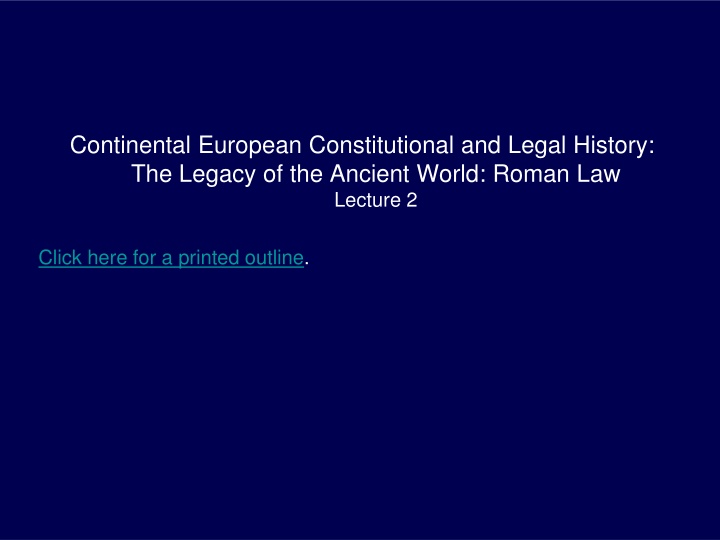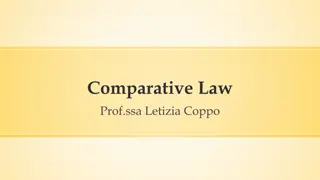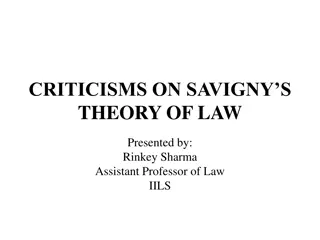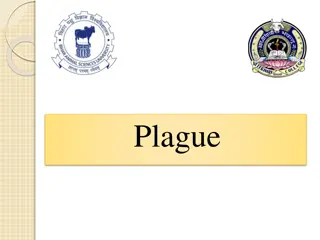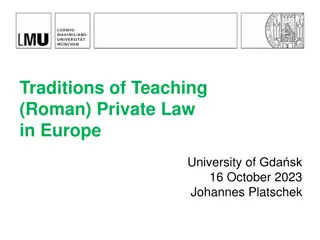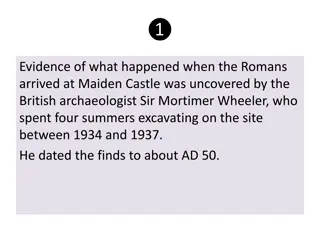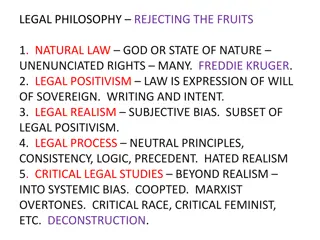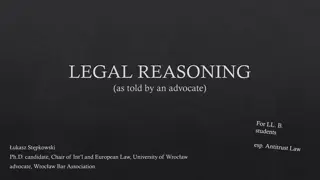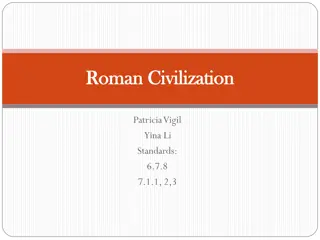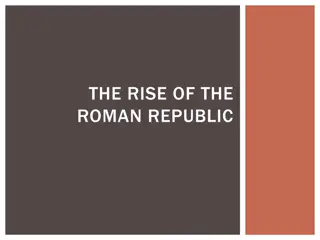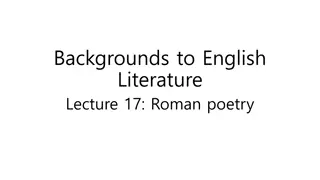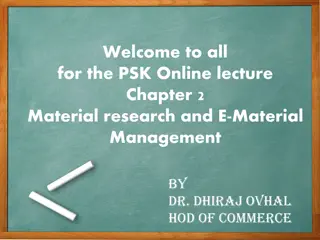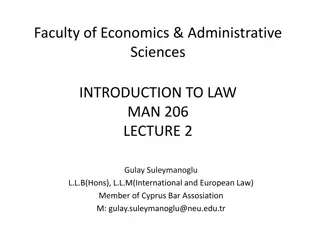Evolution of Roman Legal System and Justinian's Codification
Roman legal history is divided into several periods, from the Archaic City-State to the Classical Principate and the Post-Classical Dominate. The codification of Roman law culminated in Justinian's Corpus Iuris Civilis, which included the Digest, Institutes, Code, and Novels. Justinian's reforms established a comprehensive legal system that shaped European legal traditions.
Download Presentation

Please find below an Image/Link to download the presentation.
The content on the website is provided AS IS for your information and personal use only. It may not be sold, licensed, or shared on other websites without obtaining consent from the author.If you encounter any issues during the download, it is possible that the publisher has removed the file from their server.
You are allowed to download the files provided on this website for personal or commercial use, subject to the condition that they are used lawfully. All files are the property of their respective owners.
The content on the website is provided AS IS for your information and personal use only. It may not be sold, licensed, or shared on other websites without obtaining consent from the author.
E N D
Presentation Transcript
Continental European Constitutional and Legal History: The Legacy of the Ancient World: Roman Law Lecture 2 Click here for a printed outline.
Periodization: Roman legal history Period Description Politics Sources of Law 500-250 BC Archaic City-State XII Tables 250-1 BC Pre-Classical Urban Empire Statutes/Cases 1-250 AD Classical Principate Cases 250-500 AD Post-Classical Dominate Imperial Constitutions 550 AD Justinian Byzantine Code
The Codification of Roman Law Pur avoider le stuffing del rolls ove multip 240 A.D. End of classical period; no official collection except the praetor s edictum perpetuum (perpetual edict), a collection of formulae and rules of procedure published by the chief judge of Rome, known as the praetor. Even before the end of the classical period unpublished decisions of the emperor, known as constitutions, were becoming an increasingly important source of law. 439 A.D. Theodosian Code (begun 429). About 1/3 to 1/2 of the Theodosian Code survives. The pays de droit crit, the land of the written law, in southern third of France, owes its name to the fact that for a long period Roman law as represented by the Theodosian Code was regarded as being in force there. 527 A.D. Justinian becomes emperor 528 A.D. Justinian appoints a commission 530 533 A.D. Compilation of the Digest 533 A.D. Publication of the Digest and the Institutes 534 A.D. Publication of the Code 534 565 A.D. Justinian s Novels
Corpus Iuris Civilis contents Pur avoider le stuffing del rolls ove multip The Digest or Pandects, a mamouth collection of extracts from the writings of the classical jurists from roughly 100 BC to roughly 240 AD. The Institutes, an elementary and quite short textbook following that of the second-century jurist Gaius. The Code, a compilation of imperial constitutions (i.e., rulings by the emperor on matters of law) from roughly 100 AD to Justinian s time. The Novels, a private collection, probably made shortly after Justinian s death, of 168 constitutions that he promulgated after 534. Together, these became known as the Corpus Iuris Civilis. Extracts from the Institutes, the Digest and Code, designed to show how these books are arranged, may be found in Part I of the coursepack. Applying our tests of authoritative, systematic, and exclusive to the parts of the CJCiv: The Digest, Code, and Institutes are all authoritative. The Digest is exclusive in its sphere but not systematic, the Code is not exclusive nor is it systematic, and the Institutes are systematic but not exclusive. The Novels are neither authoritative nor exclusive nor systematic, though the constitutions that they contain may be regarded as authoritative.
The structural features of Justinians Institutes Ius vs. lex. This is not in the scheme of Justinian s Institutes. It s simply fundamental to the language. The only place where J. uses the word lex is where he is referring to statutes. Justinian s Institutes(JI.1.1.4): The study of law consists of two branches, law public and law private. Some things, e.g., rites, roads, and fields are public; some belong to individuals. Public law [lex] cannot be changed by private agreement. Livy calls the XII Tables the fountain of all public and private law. The best-known statement of the distinction is in D.1.1.2 (Ulpian): Of this subject there are two positions [an odd word in this context], public law and private law. Public law is that which regards the constitution of the Roman state, private law looks at the interest of individuals; as a matter of fact, some things are beneficial from the point of view of the state, and some with reference to private persons. Public law is concerned with sacred rites, with priests, with public officers.
The structural features of Justinians Institutes(contd) The function of the public/private distinction may have been to make the jurists feel more autonomous. Although the Roman-law texts that made the public-private distinction were known in the west after the fall of Rome and were well known from the 12th century on, but the western jurists made hardly any use of the distinction until the 16th century. That fact almost certainly tells us something about the development of the notion of the state in the west.
The structural features of Justinians Institutes(contd) JI. 1.1.4 (cont d) Of private law then we may say that it is of threefold origin, being collected from the precepts of nature, from those of the law of nations, or from those of the civil law of Rome. private law natural law law of nations civil law This is not structural. The third-century jurist Ulpian makes this three-fold distinction. The second-century jurist Gaius, on whom most of the Institutes is based makes a two-fold distinction, not separating natural law from the law of nations.
The structural features of Justinians Institutes(contd) JI 1.2pr: From Ulpian: The law of nature is that which nature has taught all animals; a law not peculiar to the human race, but shared by all living creatures, whether denizens of the air, the dry land, or the sea. Hence comes the union of male and female, which we call marriage; hence the procreation and rearing of children, for this is a law by the knowledge of which we see even the lower animals are distinguished. JI 1.2.1: From Gaius: The civil law of Rome, and the law of all nations, differ from each other thus. The laws of every people governed by statutes and customs are partly peculiar to itself, partly common to all mankind. Those rules which a state enacts for its own members are peculiar to itself, and are called civil law: those rules prescribed by natural reason for all men are observed by all peoples alike, and are called the law of nations.
The structural features of Justinians Institutes(contd) JI 1.2.2: [By the law of nations] when wars arose, <and> then followed captivity and slavery, which are contrary to the law of nature; for by the law of nature all men from the beginning were born free. The law of nations again is the source of almost all contracts; for instance, sale, hire, partnership, deposit, loan for consumption, and very many others. It is hard to exagerrate how much confusion these passages caused in later centuries. Modern scholarship, and to some extent Renaissance scholarship, suggests that the philosophical basis of Ulpian s view was Stoic, and that of Gaius, Aristotelian or Peripatetic. Be that as it may be, the Roman lawyers never thought that what was a matter of natural law could trump civil law. But as we saw from Gratian in the last lecture, medieval lawyers did. Hence, the stakes were much higher for the medieval jurists.
The structural features of Justinians Institutes(contd) JI. 1.2.12: The whole of the law which we observe relates either to persons, or to things, or to actions. all law persons (JI.1.3 1.26) things (JI.2.1 4.5) actions (JI.4.6 4.18) This is structural. It gives us the outline for the rest of the work. The law of things is broader than our property . It includes our property, but it also includes succession (our wills and trusts), and obligations (our contract and tort; what J. calls contract and delict). In modern terms the first category is capacity; the second category is substantive rights and duties; the third is remedies. Who, what and how vindicated.
The structural features of Justinians Institutes (contd) The legal realists of the first half of the last century taught us the danger of separating substantive rights from remedies. In Roman law, the sharp separation of the law of things from the law of actions was characteristic only of the institutional treatises and post-classical writing. The jurists of the Digest are acutely aware of the procedural implications of substantive rights and duties. If we look at this trichotomy from a neo-Marxist viewpoint, we might say that its function is to create a false consciousness. Book 1. Persons JI.1.3pr: : In the law of persons, then, the first division is into free men and slaves. JI.1.8pr: Another division of the law relating to persons classifies them as either independent (sui iuris) or dependent (alieno iure subiecti).
The structural features of Justinians Institutes (contd) Books 2 and 3. Things JI.2.1pr: In the preceding book we have expounded the law of Persons: now let us proceed to the law of Things. Of these, some admit of private ownership, while others, it is held, cannot belong to individuals: for some things are by natural law common to all, some are public, some belong to a society or corporation, and some belong to no one. But most things belong to individuals, being acquired by various titles, as will appear from what follows. JI.2.9.6: We proceed therefore to the titles whereby an aggregate of rights is acquired. If you become the successors, civil or praetorian, of a person deceased, or adopt an independent person by adrogation, or become assignees of a deceased s estate in order to secure their liberty to slaves manumitted by his will, the whole estate of those persons is transferred to you in an aggregate mass. JI.3.13pr, 2: Let us now pass on to obligations. An obligation is a legal bond, with which we are bound by a necessity of performing some act according to the laws of our State. . . . [T]hey are arranged in four classes, contractual, quasicontractual, delictal, and quasi-delictal.
The structural features of Justinians Institutes (contd) things (res) acquisition per universitatem (including legacies and fideicommissa) JI.2.10 2.25, JI.3.1 3.12 acquisition of single things acquisition and extinction of obligations JI.2.1 2.9 JI.3.13 3.29, JI.4.1 5 contract quasi-contract delict quasi-delict This graphic lays out the the law things from the previous slide.
The structural features of Justinians Institutes (contd) Let s try to burrow into the distinction between property and obligation, because it is clear that the middle category, succession, is in the middle because it contains both property and obligations. What separates property from obligation is not function, much less physical characteristics; it is a distinction made in Book 4, the book on procedure, in rem vs. in personam. In our legal system it means 2 things one procedural and one substantive. It is either a process that involves the seizure of a specific thing or a remedy involving a specific thing, or it is a right good as against the whole world. The distinction is a particularly troublesome one in a legal system like the Roman which doesn t award specific restitution. The distinction is kept somewhat clearer in Roman law than it is in our system by the fact that a Roman action in rem focused on the plaintiff s right not the defendant s wrong. All corporeal things were subject to actions in rem. Some incorporeal things were, and those which were tended to be those that gave in rem rights, in the second sense of the term (good as against the whole world), in a corporeal thing, servitudes, usufructs, an entire heredity.
The structural features of Justinians Institutes (contd) things corporeal incorporeal The first problem with the distinction is that all physical things are corporeal and all rights are incorporeal. This is a clue to J. s understanding of ownership, i.e., it can only be of a corporeal thing. Further, incorporeal things includes obligations. BUT obligations cannot be conveyed. (GI.2.38 9, no parallel in JI. but it s his rule too.) This is not quite true as we shall see when we get to succession per universitatem, but this eminently practical distinction forms the basis of 2+ books: things that can be conveyed singly, things that are conveyed in the aggregate, and things that cannot be conveyed singly.
The structural features of Justinians Institutes (contd) The notion of obligation is never defined in the classical texts. J.3.13pr is justly famous and is his own: An obligation is a legal bond, with which we are bound by necessity of persorming some act according to the laws of our State. For Justinian obligations are then divided: obligations (JI.3.13.1) civil praetorian obligations (JI.3.13.2) contract quasi-contract delict quasi-delict
The structural features of Justinians Institutes (contd) The development of the idea of obligation is complicated and not completely known. That J. should distinguish between civil and pretorian obligations 300 years after the distinction had ceased to have any meaning shows something of where the idea had been, as does the necessity for creating the two quasi-categories. We may expand his definition along the following lines: An obligation is a legal bond between two persons which implies the duty of one to another enforceable by an actio in personam. As a general matter, the Roman law of contractual obligations is well developed. It is controversial whether they had a general notion of contract, but they certainly had extensive law about particular kinds of contracts: loans, bailments, pledges, formal oral contracts, sale, hire, partnership, and agency all received extensive treatment.
The structural features of Justinians Institutes (contd) As a general matter, the Roman law of delictual obligations is less well developed than is the law of contractual obligations. By contrast to the modern law of tort, the Roman law of delict tended to emphasize the penal element. It was thus somewhat in between our law of tort and our law of crime. The emphasis was also on intentional acts, theft, intentional physical injury, intentional injury to someone s reputation. There is also a law of negligence, but most of the texts deal with damage to property (though we must remember that under Roman law slaves were property). There is very little about negligent injury to free persons.
The structural features of Justinians Institutes (contd) Book 4. Actions (mostly civil procedure) JI.4.6pr The subject of actions still remains for discussion. An action is nothing else than the right of suing before a judge for what is due to one. [procedure] abuse of process crime actions exceptions interdicts
The Strucutral Features of Western Law: 19th-Century Codes Code Napol on (French Civil Code) (1804): bk. 1. Of Persons. (This is where the marriage sections are.) bk. 2. Of Property. bk. 3. Of the different modes of acquiring property. (This is where the wild animal section is.) After this comes 1. Succession. 2. Donation. 3. Contracts in general. 4. Engagements formed without a contract (quasi-contract and delict). 5. Of the contract of marriage (marital property). 6 13. [Different kinds of contracts: sale, hire, partnership, loans, deposit, insurance, agency] 14 18. Security. 19. Ejectment. 20. Prescription. (The section on witnesses is in a separate Code of Civil Procedure. There is also a separate Code of Criminal Procedure (more provisions about witnesses), a Code of [substantive] Criminal Law, Commercial Law. Later a Code of Administrative Law was added.)
The 19th-Century Codes (contd) B rgerliches Gesetzbuch (German Civil Code) (1900): Bk. 1. General Part (General rules on persons, things, legal transactions, limitations, security) Bk. 2. Obligations (mostly contract, delict at very end) Bk. 3. Law of Things (wild animal provision is in here) Bk. 4. Family Law (marriage provision is in here) Bk. 5. Succession (The section on witnesses is in a separate Code of Civil Procedure. There is also a separate Code of Criminal Procedure (more provisions about witnesses), a Code of [substantive] Criminal Law, and of Commercial Law.)
The 19th-Century Codes (contd) The basic distinctions on which these codes are based are also found in the 13th-century English treatise known as Bracton and in the 18th- century treatise of Blackstone. The German Civil Code makes two major changes: The order of the three basic elements of the law of things is changed. A new category called Family Law is hived off from persons and jammed in between property and succession, and the treatment of the law of persons is expanded to include all general principles applicable to the whole code. It took a long time for these categories to become dominant in the Anglo- American world, probably not until the 19th century. I would argue that they are in backs of the minds of most Anglo-American lawyers today, though we teach them by inference rather than specifically. The categories are, moreover, distinctively western. No non-Western legal system that I know of has them, unless they are later additions borrowed from the western legal systems.
Marriage, wild animals, witnesses in Justinians Institutes J. s main reatment of the law of persons in bk. 1 is subdivided: Of their own right (sui iuris) Of another s right (in power) owner s power paternal power tutelage care [totally] from lawful nuptials from adoption In considering those persons who are in paternal power from lawful nuptials, he says:
Marriage in Justinians Institutes (contd) Roman citizens are joined together in lawful wedlock when they are united according to law, the man having reached years of puberty, and the woman being of a marriageable age [Other texts tell us that these ages are presumptively 14 and 12.] whether they be sui iuris or in potestate [all Roman children of whatever age were in the power of their fathers as long as the father was alive, unless the child were expressly emancipated.] provided that in the latter case they must have the consent of the parents in whose power they respectively are, the necessity of which, and even of its being given before the marriage takes place, is recognized no less by natural reason than by law. . . . But if parental consent is required, what if the parent is insane? Justinian tells us that he has fixed an anomaly in the classical law. The next three paragraphs outline incest prohibitions. They are not particularly extensive, ascendants and descendants and very close collaterals. The final paragraph (no. 13) seems to suggest that Justinian recognized the concept of legitimation by subsequent matrimony. It has become controversial today as to what the law about this was in J. s time. The topic was also controversial in the Middle Ages.
Wild animals in Justinians Institutes The initial divisions of Justinian s law of single things in book 2: things (res) out of patrimony in patrimony by natural law (things common to all) public of no one (nullius) of a corporation holy religious natural modes of acquistion handing over (traditio) occupation alluvion avulsion treasure specification confusion [fixtures] Occupation is a natural mode of acqusition of things that belong to no one (and, hence, are not in someone s patrimony). Of occupation of wild animals J. has this to say:
Wild animals in Justinians Institutes (contd) Wild animals, birds, and fish, that is to say all the creatures which the land, the sea, and the sky produce, as soon as they are caught by any one become at once the property of their captor by the law of nations; for natural reason admits the title of the first occupant to that which previously had no owner. So far as the occupant s title is concerned, it is immaterial whether it is on his own land or on that of another that he catches wild animals or birds, though it is clear that if he goes on another man s land for the sake of hunting or fowling, the latter may forbid him entry, if aware of his purpose. An animal thus caught by you is deemed your property so long as it is completely under your control; but so soon as it has escaped from your control, and recovered its natural liberty, it ceases to be yours, and belongs to the first person who subsequently catches it. It is deemed to have recovered its natural liberty when you have lost sight of it, or when, though it is still in your sight, it would be difficult to pursue it. It has been doubted whether a wild animal becomes your property immediately [when] you have wounded it so severely as to be able to catch it. [cont d on next slide]
Wild animals in Justinians Institutes (contd) Some have thought that it becomes yours at once, and remains so as long as you pursue it, though it ceases to be yours when you cease the pursuit, and becomes again the property of any one who catches it: others have been of the opinion that it does not belong to you till you have actually caught it. And we confirm this latter view, for it may happen in many ways that you will not capture it. Bees, again, are naturally wild . . . [skipping to the end of the section]. A swarm which has flown from your hive is considered to remain yours so long as it is in your sight and easy of pursuit: otherwise it belongs to the first person who catches it.
Witnesses in Justinians Institutes There is nothing about witnesses in the Institutes. There are, however, titles on witnesses in both the Digest and the Code, both of which are included in full in Chapter 1 of the Materials, p, I 33 and I-35. By comparison with the title on marriage, the Digest title is very short. Why? What little material that there is is late. One can tell this by looking up the names of the jurists. Much of it seems to be context-specific, i.e., whether a conviction of adultery bars that person from testifying under the provisions of certain statutes passed in the Augustan age. To the extent that there are general principles, they seem to be quite broad. E.g., the recript of Hadrian quoted in D.22.5.3.1: You know best what weight to attach to witnesses, what their dignity and reputation is, who speaks simply, and whether they keep to a premeditated story, or give likely answers to your ex tempore questions. The concern for fixed rules about witnesses seems to have increased in the later empire. Nothing, however, gives us a basic form of procedure for the use of witnesses. That is simply assumed. Hence, while the passages on marriage and wild animals gave us quite a bit of what we have in the 19th century codes, the Roman law on witnesses gives us relatively little.
Wild animals, marriage and witnesses: 19th-century codes Wild Animals The Napoleonic Code (1804) [3. Of the different modes of acquiring property. General dispositions.] 711. Ownership in goods is acquired and transmitted by succession, by donation between living parties and by the effect of obligations. 712. Ownership is also acquired by accession, by incorporation, and by prescription. 713. Property which has no owner belongs to the nation. 714. There are things which belong to no one, and the use whereof is common to all. The laws of police (lois de police) regulate the manner of enjoying such. 715. The right of hunting and fishing is alike regulated by particular laws.
19th-century codes: wild animals (contd) The Austrian Civil Code (1811) [2. The law determining rights to things. 1. Of real rights. 3. Of the acquisition of property by occupancy.] 381. For vacant (freistehenden) things the title consists in the inborn liberty to take possession of them. The mode of acquisition is occupancy, by which one seizes a vacant thing with the intention to treat it as his own. 382. Vacant things can be acquired by all members of the State by means of occupancy, insofar as this right is not restricted by political laws (politische Gesetze), or insofar as some members do not have the privilege (Vorrecht) of occupancy.
19th-century codes: wild animals (contd) 383. This holds good especially in regard to the catching of animals. It is determined in the political laws, to whom the right of hunting or fishing belongs; how immoderate increase of the game will be checked, and damage caused by game will be compensated; how stealing of honey, which is produced by the bees of another person is to be prevented. The criminal laws determine how poachers are to be punished. 384. Domestic swarms of bees and other animals, which are tame or have been tamed, are not an object of the free catching of animals; on the contrary the proprietor has the right to follow them on the land of another person, but he must make up any damage caused to the proprietor of the land. In case the proprietor of a bee-hive kept for breeding has not followed the swarm within two days; or in case an animal, which has been tamed, has remained away of itself for forty two days, every one can take and keep it on common ground and the proprietor on his land.
19th-century codes: wild animals (contd) The Italian, Spanish, German and Swiss codes are very close to the Austrian. The German is perhaps furthest away because it leaves the principle of occupancy to inference, but the Swiss returns to it. All seem fixated on bees; all are at pains to mention that there is public law on the topic.
19th-century codes: formation of marriage French civil marriage (there s no mention of religious). Takes place before a civil officer, traditionally the mayor of the town. He reads the aforementioned documents : the banns, any opposition to the banns and any renunciation, the birth certificates of the parties, the consents of the parents; then he reads 1.5.6 of the Code which begins 212. Married persons owe to each other fidelity, succour, assitance. 213. The husband owes protection to his wife, the wife obedience to her husband. He receives from each party his/her consent; he pronounces them husband and wife in the name of the law and immediately makes up a marriage certificate. Parents have right to oppose the marriage of their children. The Austrian code seems to contemplate a religious marriage (with some preference in language being given to the Catholic), but the form is very similar to the French as is also is the necessity for parental consent. The Italian is very similar to the French.
19th-century codes: formation of marriage The Spanish refers Catholics to the canon law, with a provision about parental consent, though its absence is not invalidating. The basic provision is worth quoting: 42. The law recognizes two forms of marriage, the canonical which all who profess the Catholic religion should contract, and the civil, which shall be celebrated in the manner provided in this Code. The form of civil marriage, then, is like the French. The German provision is also remarkably like the French despite differences in detail. The Swiss is even closer to the French.
19th-century codes: witnesses The unity of the systems is less clear in the provisions concerning witnesses. What they do seem to have in common (at least a majority of them) is a list of people who can either (a) refuse to testify, (b) are incapacitated from testifying, or (c) can be reproached if they do testify. Blood relatives are the most commonly mentioned, but others (e.g. the one who has eaten at the expense of a party) are mentioned as well. The consequences (this is most clearly seen in the French provisions) have to do with a system of taking written depositions. The French provision says that the reproached witness s deposition is taken, but then if the reproach is admitted the deposition is not read.
